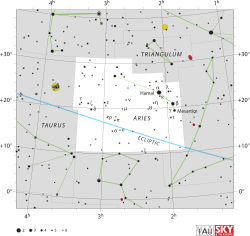Pi Arietis

| |
| Observation data Epoch J2000 Equinox J2000 | |
|---|---|
| Constellation | Aries |
| Right ascension | 02h 49m 17.55924s[1] |
| Declination | +17° 27′ 51.5168″[1] |
| Apparent magnitude (V) | 5.21[2] |
| Characteristics | |
| Spectral type | B6 V + A0 V + F8 V[3] |
| U−B color index | –0.47[2] |
| B−V color index | –0.06[2] |
| Astrometry | |
| Radial velocity (Rv) | +8.8[4] km/s |
| Proper motion (μ) | RA: +2.60[1] mas/yr Dec.: –14.10[1] mas/yr |
| Parallax (π) | 4.18 ± 0.69[1] mas |
| Distance | approx. 800 ly (approx. 240 pc) |
| Details | |
| Rotational velocity (v sin i) | 70[5] km/s |
| Other designations | |
Pi Arietis (π Ari, π Arietis) is the Bayer designation for a multiple star system in the northern constellation of Aries. Based upon parallax measurements made during the Hipparcos mission, this system is approximately 800 light-years (250 parsecs) distant from Earth and has an apparent visual magnitude of 5.21. This is bright enough to be faintly seen with the naked eye.
The primary member of this system is a massive, B-type main sequence star with a stellar classification of B6 V. It is a close spectroscopic binary with an orbital period of 3.854 days, an eccentricity of 0.04, and a combined visual magnitude of 5.30. At an angular separation of 3.28 arcseconds is a magnitude 8.46 A-type main sequence star with a classification of A0 Vp. Finally, a fourth member of the system is a magnitude 11.0 F-type main sequence star with a classification of F8V at an angular separation of 25.2 arcseconds from the primary.[3]
Name
This star, along with δ Ari, ε Ari, ζ Ari, and ρ3 Ari, were Al Bīrūnī's Al Buṭain (ألبطين), the dual of Al Baṭn, the Belly.[7] According to the catalogue of stars in the Technical Memorandum 33-507 - A Reduced Star Catalog Containing 537 Named Stars, Al Buṭain were the title for five stars : δ Ari as Botein, π Ari as Al Buṭain I, ρ3 Ari as Al Buṭain II, ε Ari as Al Buṭain III dan ζ Ari as Al Buṭain IV.[8]
In Chinese, 左更 (Zuǒ Gēng), meaning Official in Charge of the Forest, refers to an asterism consisting of π Arietis, ν Arietis, μ Arietis, ο Arietis and σ Arietis.[9] Consequently, π Arietis itself is known as 左更五 (Zuǒ Gēng wu, English: the Fifth Star of Official in Charge of the Forest.)[10]
References
- 1 2 3 4 5 van Leeuwen, F. (November 2007), "Validation of the new Hipparcos reduction", Astronomy and Astrophysics, 474 (2): 653–664, arXiv:0708.1752
 , Bibcode:2007A&A...474..653V, doi:10.1051/0004-6361:20078357.
, Bibcode:2007A&A...474..653V, doi:10.1051/0004-6361:20078357. - 1 2 3 Crawford, D. L.; Barnes, J. V.; Golson, J. C. (1971), "Four-color, H-beta, and UBV photometry for bright B-type stars in the northern hemisphere", The Astronomical Journal, 76: 1058, Bibcode:1971AJ.....76.1058C, doi:10.1086/111220.
- 1 2 Eggleton, P. P.; Tokovinin, A. A. (September 2008), "A catalogue of multiplicity among bright stellar systems", Monthly Notices of the Royal Astronomical Society, 389 (2): 869–879, arXiv:0806.2878
 , Bibcode:2008MNRAS.389..869E, doi:10.1111/j.1365-2966.2008.13596.x.
, Bibcode:2008MNRAS.389..869E, doi:10.1111/j.1365-2966.2008.13596.x. - ↑ Wilson, Ralph Elmer (1953), General Catalogue of Stellar Radial Velocities, Washington: Carnegie Institution of Washington, Bibcode:1953GCRV..C......0W.
- ↑ Abt, Helmut A.; Levato, Hugo; Grosso, Monica (July 2002), "Rotational Velocities of B Stars", The Astrophysical Journal, 573 (1): 359–365, Bibcode:2002ApJ...573..359A, doi:10.1086/340590.
- ↑ "42 Ari -- Star", SIMBAD Astronomical Database, Centre de Données astronomiques de Strasbourg, retrieved 2012-08-07.
- ↑ Allen, R. H. (1963), Star Names: Their Lore and Meaning (Reprint ed.), New York, NY: Dover Publications Inc, p. 83, ISBN 0-486-21079-0, retrieved 2010-12-12.
- ↑ Rhoads, Jack W. (November 15, 1971), "Technical Memorandum 33-507-A Reduced Star Catalog Containing 537 Named Stars" (PDF), Jet Propulsion Laboratory, California Institute of Technology.
- ↑ (Chinese) 中國星座神話, written by 陳久金. Published by 台灣書房出版有限公司, 2005, ISBN 978-986-7332-25-7.
- ↑ (Chinese) AEEA (Activities of Exhibition and Education in Astronomy) 天文教育資訊網 2006 年 5 月 21 日